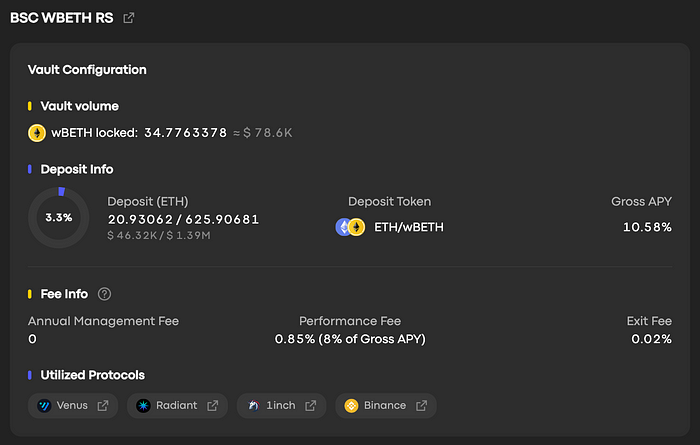
1. The Strategy
The WBETH leveraged staking strategy aims to amplify WBETH’s staking yield by leveraging (4x) the amount originally deposited by recursively borrowing ETH, using Venus as the core lending platform, and 1inch as the core swap aggregator.
To further cement security, CIAN’s vaults come equipped with a monitoring module that can adjust the position’s collateral ratio to protect users against liquidation risk.
- Users may choose to deposit ETH or WBETH. The same choice applies upon withdrawal.
- This strategy’s total APY* is equal to the differential between Positive yields minus the borrowing rate.
- The positive yield comes from the Staking yield APR + Supply APR.
- The negative yield comes from the Borrowing rate (APR).
- The equation goes as follows:
TotalAPY = 4 x (WBETHStakingYield + WBETHSupply APR) — 3 x (ETHBorrowRate)
*Important note: This strategy incurs swap fees upon creation and withdrawal (due to gas fees & swap slippage, mostly incurred upon withdrawal). Therefore, a breakeven time applies. Depending on the onchain swap rate and strategy APY, the breakeven time may vary from 5–15 days. Users shall be informed before depositing in the vault.
2. The Vault
The vault architecture was implemented following the ERC-4626 tokenized vault standard in order to maximize the capital efficiency on BSC by fragmenting gas fees** between users.
** As demonstrated in section 3 “Workflow”, the execution of such a strategy requires multiple transactions, hence potentially representing considerable gas fee losses for single depositors.
- Management fee: 0%
- Performance fee: 8% (8% of gross APY)
- Exit fee: 0.02% (0.02% of NAV)
The vault architecture was last fully audited by Omniscia in April 2023 (same architecture used for the wstETH vault).
A total of 5 audits have been performed by 3 different auditing firms (PaladinBlockchainSecurity/ Omniscia/ Peckshield) over the last 2 years. An additional 3 internal codebase reviews have been performed by MatrixPort, OKX, and Morpho.
More details about CIAN’s audits can be found HERE
3. Workflow
The following workflows present the step-by-step processes taking place in the backend upon users’ deposit/withdrawal.
All respective steps {A-F} & {A-E} are automatically executed within 1 block transaction. For the sake of clarity, let’s assume that 1 ETH = 1 WBETH:
1. Deposit (1 ETH)
A. 1 ETH is converted to 1 WBETH using PancakeSwap’s staking contract (or swapped, depending on which approach is more cost-effective);
B. 1 WBETH supplied on Venus as Collateral;
C. Using this collateral, borrow 0.7 ETH;
D. 0.7 ETH is converted to 0.7 WBETH using PancakeSwap’s staking contract (or swapped, depending on which approach is more cost-effective);
E. 0.7 WBETH supplied on Venus as collateral (total 1.7 WBETH);
F. Repeat steps C, D & E until the position reaches 4 WBETH supplied as collateral on Venus (4x). Since the user initially deposited 1 ETH, 3 ETH had to be borrowed in order to fully leverage his position.
The user ends up with 4 WBETH supplied, and 3 ETH borrowed.
2. Yield
Once the position is created, no further transactions are necessary for the yield to be generated***. As long as the borrowing rate doesn’t surpass the staking APR, the strategy will keep generating returns. Since the staking APR comes from Ethereum’s validation fees, unless Ethereum dies off, it is very unlikely to see this strategy become irrelevant.
*** The only extra execution possible is the readjustment of the collateral ratio in case of extreme market fluctuations. If the price of WBETH was to deppeg from ETH, this might cause a risk of liquidation to any active leveraged stakers. To prevent this risk, CIAN’s vaults come equipped with a liquidation protection mechanism that can partially deleverage the vault to counter liquidation. This specific mechanism is one of the prime reasons why many institutions choose CIAN as an investment tooling platform.
3. Withdrawal (1 ETH)
A. Having 4 WBETH as collateral and 3 ETH borrowed, to return user’s assets, the ETH borrowed first has to be repaid. To do so, first withdraw a small part of the collateral (e.g, 0.3 WBETH);
B. Swap 0.3 WBETH to 0.3 ETH on 1inch;
C. Repay 0.3 ETH from the active debt;
D. Repeat steps A, B & C multiple times until all the debt has been repaid, leaving 1 WBETH as collateral.
E. Withdraw the remaining collateral. 1 WBETH withdrawn to user’s EOA wallet, or, swap WBETH to ETH, and then send this ETH to user’s EOA wallet (if the user prefers receiving ETH).
4. General Questions — WBETH
1. What’s CIAN’s track record when it comes to security?
In two years of operation, CIAN successfully underwent 5 commercial audits, gathered nearly $100m TVL, and never suffered from smart contract breeches. Despite offering high-leveraged strategies, CIAN users went through FTX/UST sagas and left unscarred. To this day, CIAN never had 1 case of liquidation.
2. Can I lose money using CIAN?
Yes, early withdrawals can easily lead to -ve ROI. As every leveraged staking strategy comes with a breakeven period, regardless if users are using CIAN or investing manually, profit will only be achieved once execution/withdrawal transaction fees are covered. The breakeven period may vary based on WBETH’s staking APR, ETH’s borrow rate, and WBETH/ETH swap rate.
Check WBETH/ETH Strategy Vault here: WBETH vault
For any additional questions, please visit CIAN’s official DISCORD








